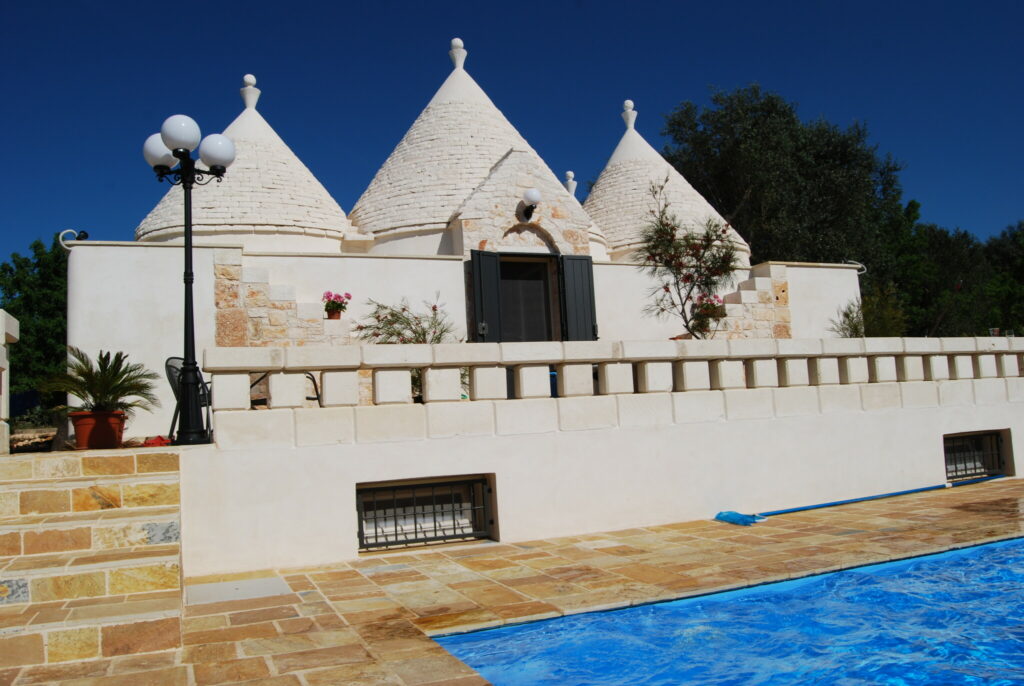You don’t need to be any kind of wine expert to be able to enjoy Puglian wine. But a lot of people like to have an idea about different types of wine so this quick guide may be helpful.
It is not surprising that Italian wines seems complicated, with masses of different types and names. The starting point is 350 officially recognised grape varieties grown in Italy – we have read this compares with about 50 in France and 6 in Australia. Wine can be made from a single grape variety (eg Trebbiano, Pinot Grigio, Sangiovese), but often it involves a combination of varieties, to make the most of different grape qualities. We estimate about 50 varieties are grown and used in Puglian wines, but the grape varieties most closely associated with the region are Primitivo, Negroamaro and Nero di Troia from which red wine is almost always produced; and Verdeca which produces white wines. You can buy wine made from any of these varieties alone; and they are all used in combination with other varieties.
Italian wine is classified into four categories of quality – Vino da Tavola; Indicazione Geografica Tipica (IGT); Denominazione di Origine Controllata (DOC); and Denominazione di Origine Controllata Garantita (DOCG). Each category is subject to Government regulations, the latter two categories are linked to the European Union quality framework of Quality Wine Produced in a Specific Area.
Vino da Tavola can be made from any type of grape, the legal requirements are limited but it must be produced somewhere in Italy. If you get a very cheap vino della casa (house wine) in a jug, it may well be of this quality; perfectly OK to drink, usually made from local grapes.
IGT is an official recognition that the wine is made from grapes in a particular geographical area ie it is a local wine. Although acceptable types of wine and grape varieties are specified, these are not very restrictive. The IGT areas are quite broad. In Puglia IGT wines may be described as from Puglia in general, or from one of five sub regions – Daunia, Murgia, Valle d’Itria, Salento, Tarantino. (For these purposes Ostuni is in the Valle d’Itria IGT area). A vino della casa will normally be of IGT quality, especially if it is described as “local”.
DOC is the designation of wine of defined quality from grapes grown within a precisely specified area. Wine designated as DOC must not only come from grapes grown in that area, it must also meet some precise requirement of acceptable grape varieties, grape quality, grape variety mixtures, wine making methods etc. Sometimes the label just gives the DOC area name (eg Copertino, Locorotondo); sometimes it also includes the type of wine or grape variety (eg Nardo Rosso, Primitivo di Manduria). The term riserva is usually allowed if the wine has been matured for a minimum of two years, implying a higher quality. Over the last 20 years in Puglia there has been a deliberate push to improve quality of wine. There are now 29 DOC areas, covering most but not all of the territory in the region. There is a small DOC area based on Ostuni with two types of wine – Bianco made mainly from Impigno grapes, and a red wine called Ottavianello made from at least 85% Ottavianello grapes. You are only likely to be able to buy these in Ostuni. However a few DOC wines from Puglia are now widely available world wide.
DOCG wines are a special category of DOC wines, The criteria applied are demanding, and there is a system for independent assessment and tasting to guarantee the highest quality. DOCG wine is usually in bottles with a special seal and is invariably expensive. The most famous names in Italian wine are usually DOCG quality. As Puglian wine production gains in experience, DOC wines are gradually establishing themselves as potential DOCG contenders. There are so far four DOCG wines – two reds and a rosato (DOCG quality rosato wines are rare) from the Castel del Monte area in the north of the region; and a naturally sweet red wine from the Manduria area using Primitivo grapes (NB not to be confused with the widely available Primitivo di Manduria, which is “just” DOC).

